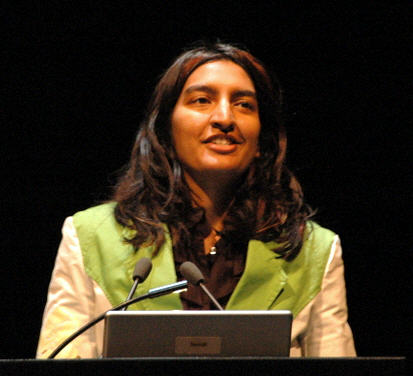Facebook: Committed to the sanctity of the social graph

Just 24 hours after Facebook received $240 million from Microsoft for 1.6 percent of the company, Ami Vora, senior platform manager at Facebook, said that investment news (which probably wasn't any surprise to Facebook employees) wasn't a big deal for anyone she talked to. "We are really focused on what we build. Resources are great, but we are intent on building the vision. I just worked more [after the Microsoft investment news]," she said.
Surely, the 300 Facebookers must have spent a few seconds contemplating what it means to have stock options in a company that assumed a mythical $15 billion valuation on $150 million in revenue.
"Facebook is a place where you think a lot and see what happens," Vora said describing the company ethos.
Formerly a product manager for the .NET Development Platform and Vista Developer tools at Microsoft, Vora was speaking at the SNAP Summit on the Facebook Platform.
She was asked about whether Facebook wants to "own" everything.
"We want others to play in this marketplace. We are going to leave a lot of money on the table. We can't do everything ourselves," she said. "Do we want to own everything? Perhaps, but the best possible user experience is not if we own everything. The only way to create that is if other people play in the market....That said, we will see what works. It's up to users. We will never try to force people out of business explicitly."
In other words, if Facebook sees and good business opportunity or way to do something better than its developers for users, the company won't hesitate to strike.
Vora said that Facebook was "committed to the sanctity of the social graph," which the company defines as "the network of connections in the real world through which people communicate and share information."
"We are trying to build the most accurate representation, a digital mapping of how people interact in real world," Vora explained.
She brought the canonical Facebook photo application as the example of how the social graph can work. Facebook Photos isn't feature rich like other services, but it has more traffic because of the social tagging tied into the social graph. Photos are propagated as more users tag people and share with their Facebook friends. It's an indicator of social interaction and the social graph, Vora said.
During the Q&A Vora was asked who Facebook views as a competitor? "That's an excellent question," she responded. "I am sure if I threw out a some name I would get an angry call from someone at Facebook." As she tried to figure out a way to answer the question without stepping on toes, she said that perhaps the social graph of mirroring what people do in the real world competes with TV or petting your dog.
With 49 million users consuming an amazing 50 Facebook pages a day on average, the social graph is taking away time from other activities...including work. "Why do people come back for 50 pages a day," Vora asked the crowd. "It's all about the social graph."
Part of the growth is driven by the Facebook Platform and applications. So far, there are 5,400 Facebook applications, with 100 new ones arriving every day, Vora said. Eight-five percent of Facebook users have at least one applications and 88,000 developers have signed up for a key.
The first wave of applications in the five months since the Facebook Platform launched has been dominated by entertainment--musics, food fights, etc. "We'll see applications that take more than five months [to develop]. As the platform matures and users think about different applications, we'll see demand for very different applications emerge," Vora said. "It's just the beginning, We recognize that we made a lot of mistakes, but we always try to recover and work for the best long term platform."
Facebook is also looking at how to incorporate brands into the social graph. "We definitely have to think hard about how to incorporate brands into social graph in a way that makes sense. It's not your friends," Vora said. "The underlying motivation is what provides utility for users."
She gave advice to the developers assembled at the conference:
- Provide engaging content, focusing on relevant information, showcasing interaction, usability and fresh content
- Use the integration points into Facebook (12 touchpoints)
- Think about adding value
- Develop and iterate--low investment, quick feedback and lots of control
- Intelligent promotion--figure out how to incentivize users to use your application
- Incorporate privacy
